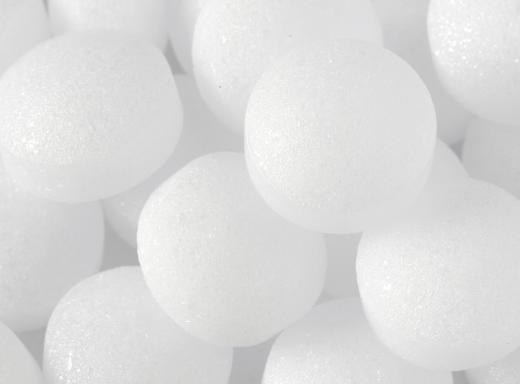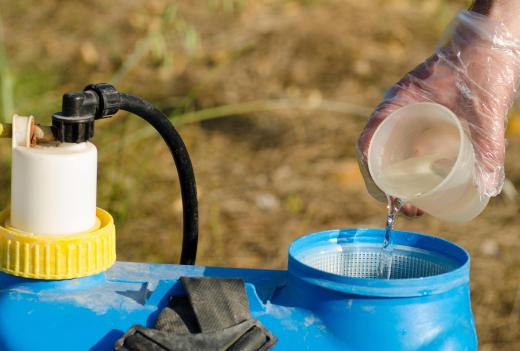What is Naphthalene?
Naphthalene is a carbon-based chemical that is most commonly used to make mothballs. It has the chemical formula C10H8, and is known within the scientific community as a polycyclic aromatic hydrocarbon. This chemical is found in nature but scientists can also synthetically create it in a lab. In addition to mothballs, it is used to make insecticide, many resins and solvents, and a range of lubricants and household products. Many cigarettes contain it, too. People who are regularly exposed to the chemical often experience negative health consequences. It’s usually considered safe for use in small amounts, but when ingested or constantly inhaled it can lead to nausea, headaches, and organ damage.
Main Sources

In most cases the compound starts out as a white solid with a very distinctive smell. It is sometimes also marketed as naphtha, nafta, tar camphor, or moth flakes, depending on the purpose for which it’s being sold. The original sourcing for this compound comes from nature. A few substances naturally contain naphthalene; it is found in trace elements in many fossil fuels as well as in the ash of timer and tobacco. Scientists frequently isolate it through a straining and filtration process, and it is sometimes also created synthetically. Man-made copies usually have the same chemical attributes but are often easier and faster to isolate.
Use as a Moth Repellant

This product is most commonly used as a moth repellant. Moths are small winged insects that live in most parts of the world and typically eat wool and certain other animal-based products. They can be difficult to deter since they are able to squeeze through small spaces and eat through a variety of materials. They tend to have a very particular sense of smell, however, and they won’t usually come near scents they find offensive. Naphthalene-containing products are typically some of the most effective.

People often pack sweaters away with mothballs and may scatter chemically laced chips or flakes in closets containing wool suits, blankets, and other goods. Some manufacturers also weave flakes into their products or coat certain fibers in liquid versions of the chemicals to provide a sort of constant protection, though this is more common for wool that has a utilitarian purpose than for wool that is worn directly on the skin.
Industrial Applications

Although naphthalene is typically first extracted as a solid, it is easily converted to liquid and gas. As a particulate suspended in gas it can combust relatively easily, and it’s often used in explosives as a result. The chemical also dissolves in alcoholic liquids such as acetone. It’s commonly added to leather tanning products, insecticides, and a range of industrial antiseptics, lubricants, dyes, resins, and solvents. Many plastics also have it as an ingredient.
Risks and Precautions

Since this chemical is involved at least to some degree in the manufacture of so many different products, both workers and consumers may be exposed to it and its potential dangers. Employees in factories and manufacturing plants typically learn how to take precautions that can reduce their exposure to the liquid or gas. The general public must also be careful when using mothballs even in the course of ordinary clothing storage since they can cause serious health problems when used incorrectly. Children are often more at risk than adults, too.
For instance, fumes may overwhelm a child wearing a sweater recently removed from a chest full of mothballs. Inhaling the chemical can lead to nausea, vomiting, fatigue, headache, fever, confusion, and fainting. As a result, it’s usually a good idea to give clothing time to air out before wearing it, or get garments professionally cleaned if possible.
Routine exposure can cause a condition called hemolytic anemia, in which a person's red blood cells become damaged and start failing to properly oxygenate the body. Ingestion or prolonged skin exposure has been known to cause more extreme reactions in the liver and bladder, causing jaundice, lightheadedness, and possibly even leading to coma. Cigarette smoke contains the chemical, too, which can lead to respiratory problems over the long-term. Manufacturers usually recommend keeping mothballs and related products well out of the reach of children, and encourage people who work with the chemical to wear a protective mask and take breaks for fresh air as needed.
AS FEATURED ON:
AS FEATURED ON:















Discussion Comments
We have had to throw away several frames because the moths got into the beehives before we treated them and ruined them. It really doesn't take very long for a hive to sit empty for the moths to take over. Once they do, you really have a mess and it is just a whole lot easier to treat them right away instead of waiting.
If the hives are stored in an inside area, the strong odor of the mothballs is almost overwhelming. I can see why it keeps the moths away as the odor is so strong that I want to stay away as well. I guess I never realized how potentially harmful this chemical can be.
Not until I read this article did I finally realize why I had such a strong reaction when I first wore sweaters in the winter. My mom would store our off-season clothes like sweaters in mothballs. I don't know if she washed these before we wore them or not, but I always got sick when I started wearing them.
I would get a headache and feel slightly sick to my stomach. I just always thought I was coming down with something, but now I realize it must have been the odor of mothballs from the sweaters.
@SarahGen -- I wonder if cedar chips would work the same as a cedar chest at keeping the moths away. When I graduated from high school I was given a lovely cedar chest. I store items of clothing in here that I don't use all the time, but don't want to get ruined hanging in a closet somewhere.
The scent of cedar is so much more appealing than the smell of mothballs. I have always dreamed of having a cedar closet, but that has never happened yet.
I have never liked the smell of mothballs. Whenever I walk into a second hand store that sells clothing this is the first thing I smell. It is strong enough that it really bothers me and I rarely step foot in a store like this because of this strong smell.
@anon275620-- It definitely is harmful. Headaches are a result of inhaling too much naphthalene. If you also get symptoms like nausea and vomiting, you might have naphthalene poisoning.
Can you wear a mask while you work?
@fBoyle-- It hasn't been proven that naphthalene causes cancer in humans but there are studies which show that it does cause cancer in rodents. Infants and children are at much higher risk than adults.
You can use moth balls made with paradichlorobenzene instead of naphthalene. Or you can use cedar chips or horse chestnuts which are natural insect repellents.
@anon4903-- I don't know for sure but I have been told to always wash clothes that were packed with moth balls before wearing them.
I think people used to be less informed about naphthalene in the past and used moth balls a lot. But now doctors are saying that using moth balls causes cancer. If you're smelling the naphthalene, it means the chemicals are in the air.
I just wish there was a safe alternative to moth balls because they work really well at keeping moths away.
I'm excavating on an old tannery and the ground is black. I've been told it's Naphthalene and I would have to be sat on for six months to do any harm but after only a few hours I've got a headache from the fumes. Is it harmful or not?
I need help. As you know, the diesel fuel is composed of about 75 percent saturated hydrocarbons (primarily paraffins including n, iso, and cycloparaffins), and 25% aromatic hydrocarbons (including naphthalenes and alkylbenzenes).
My 1uestion: I need to remove the naphthalenes and alkylbenzenes from diesel fuel and am looking for know how.
@horndor: I am looking for info about termites emitting napthalene gas. Do you have termites? I hope you find the cause of the problem in your basement. I would have liked to ask you more questions about your gas odors.
can naphthalene be used for head lice treatment? if yes are there any ill effects on the brain?
I got a couple of questions:
1. what is the physical state of pure napthalene at room temperature?
2. Is freezing napthalene a physical change or chemical change?
We have a smell permeating from our basement that smells a lot like moth balls. We do not use moth balls so we are stumped as to where the smell is coming from. We had a dehumidifier running and thought maybe somehow that was the source so we shut it off. It has been off for two days, but there is still a smell. Any ideas?
can napthalene be used to kill the lice of the hair?
Question: Once moth balls are removed, is the smell left from the moth balls toxic if inhaled? Once moth balls are removed, does the naphthalene gas linger with the smell left in wood or on clothes; thus the "smell" is toxic?
Post your comments